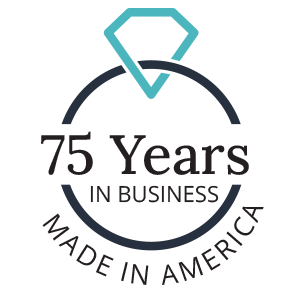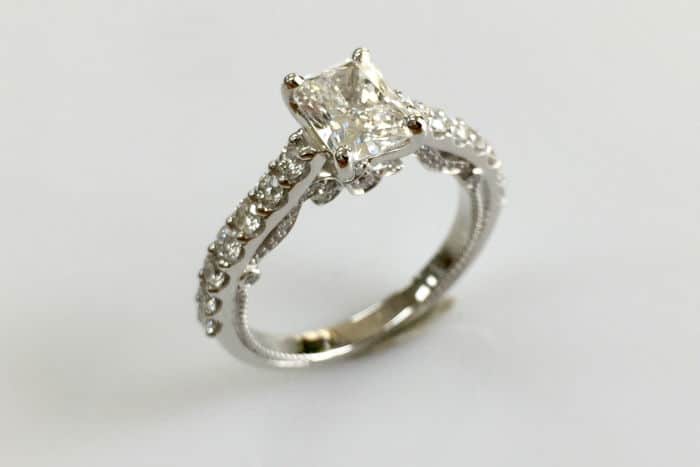If you thought buying a diamond was as simple as setting a budget, choosing something sparkly in a size as big as you can afford, then taking the prize home to your love, gasps of delight guaranteed, think again! Buying a diamond is way more than “have money, will spend on a diamond, any diamond will do.” Of course, with the right jeweler helping you, it doesn’t have to be as stressful – on your brain or your budget – as a Google search would have you believe either! Which is exactly what we are here for. Read on for our Keezing Kreations simplified guide to buying a diamond.
Step 1: Know Your Budget
There are plenty of made up rules out there telling you how much you should spend on a diamond. Don’t fall prey to these rules! They are designed to pressure you into spending more, oftentimes more than you can afford, and oftentimes unnecessarily! (To help you get over any preconceived notions you might have about these budget ‘rules’, read our take on how much you should be spending on a custom-made ring, which will put you in a great frame of mind to start the process of setting your budget for your diamond.)
That being said, diamonds are expensive, there is no getting away from it. So it is important that you set your budget up front which will help inform your decision on the size and quality of diamond you can afford.
Your budget should also take into account the cost for the overall ring or jewelry item you are designing. In other words, you must set a limit on what you can afford to spend for the entire purchase. Your calculations should therefore take into account the following:
- Center stone (aka diamond or other stone)
- Any accent stones
- Band metal (gold, platinum etc.)
- Jewelry design and setting
Once you have decided on numbers two and three, and worked out a price with your jeweler for number four, you can then subtract the cost of the jewelry item setting itself from your total budget, leaving you with the amount you can spend on the main attraction – the diamond – alone.
Now that you have your budget for the diamond itself, you can work with your jeweler to find a diamond (or other stone – see Step 3) that works for both your budget and your heart’s desire.
Step 2: Know the Four Cs
If you’ve been Googling or researching buying diamonds, you will, for sure, have stumbled across something about “the four Cs”.
A diamond’s quality is determined by the 4Cs, which refer to:
- Cut
- Color
- Clarity
- Carat
Each of these elements plays a different role in how a diamond looks, how it twinkles, how it delights… and how much it costs!
C #1: Cut
Don’t be confused between “shape” and “cut”: where shape refers to the outline or visual form of the stone, cut refers to the facet arrangement, angles, proportions, dimensions of a particular shape, and the finishing details of a diamond. In other words, a gem-cutter will shape the diamond into angles and facets to manipulate how the light will shine through the stone.
To learn more about cut vs. shape, read this: The Difference Between Diamond Cut & Shape
But why does cut matter? Well, for one thing, the cut of a diamond determines light performance – the sparkle, fire, brilliance, and overall visual beauty of the diamond as the light hits it. It goes without saying then, that certain cuts will fare better in terms of light performance, which then leads to the impact of cut on price: diamonds which sparkle brighter, thanks to cut, will cost more. Which makes the diamond cut the single biggest factor in the price tag of said diamond!
Knowing how the cut changes the price can save you a lot of money on your engagement ring – or help you determine which of the four C’s to prioritize in your budget.
Each diamond is assigned one of four cut grades by the GIA (Gemological Institute of America), with the grade reflecting both the appearance and the price of the diamond. The grades are as follows:
Excellent: the highest grade, with diamonds presenting maximum sparkle and brilliance due to little or no light leakage happening as light passes through the diamond.
Very Good: cuts of this grade showcase diamonds which are very brilliant with minimal light leakage.
Good: diamonds with a cut graded “good” capture light well, possess high degrees of sparkle, and while they might have some light leakage, still shine bright. Gem cutters might sometimes even cut to “Good” proportions on purpose to achieve a particular look or style. Your average customer will still be delighted by the sparkle in a diamond graded as having a “good” cut, so it’s an option to opt for this grade if you’re on a tighter budget.
Fair & Poor: Diamonds with a Fair or Poor grade leak noticeable amounts of light from being too deep or shallow, and show little brilliance or sparkle. Buyer beware.
C #2: Color
Color is a measure of how colorless a diamond is. Once again, this is based on a grade scale set by the GIA, with the closer a diamond being to colorless, the rarer (and more expensive) it is:
- Diamonds graded D-F are termed ‘colorless’ and appear icy white
- G-J are ‘near colorless’ and to most viewers still appear in the icy white range
- K-Z diamonds exhibit ‘noticeable color’ which can be as obvious as a pale yellow hue
While many discerning diamond buyers will insist on buying only the best, selecting only from diamonds in the D-F colorless range, the truth is that the ‘color’ exhibited by diamonds graded G-J is most often completely indiscernible to the average person! What this means is that color could be a place where you can compromise on quality or grading to help with your budgeting constraints. Diamonds in the G-J range offer exquisite looks and great value.
Note: “Fancy colored” diamonds are something completely different. These are diamonds which exhibit color outside of the normal color range set out by the GIA. Think pink, grey, brown, yellow… Indeed, diamonds actually come in every color of the rainbow, but be warned: some are considered very rare and can be even more expensive than white diamonds of similar carat weight and quality.
C #3: Clarity
Clarity, which refers to how clean the diamond is of inclusions and blemishes, is graded from flawless (perfect with zero imperfections visible even at 10x the magnification) to included (very obvious blemishes clearly visible to the naked eye). The GIA gives the following ratings for clarity:
FL/IF: Flawless/Internally Flawless
VVS1/VVS2: Very Very Slightly Included; only a strong microscope can reveal pinpoint inclusions or blemishes.
VS1/VS2: Very Slightly Included; here a jewelers loop can probably pick up any inclusions, rather than a stronger microscope, but these are still invisible to the naked eye.
SI1: Slightly Included (1); made up of more than one tiny inclusion, this clarity grading is often given to diamonds which still mostly look flawless to the naked eye. Under a jeweler’s loop, however, any inclusions or imperfections are obviously visible.
SI2: Slightly Included (2); with certain cuts – like the Emerald and Asscher for example, an inclusion with SI2 clarity is almost always visible to the naked eye.
Obviously, the lower the number of imperfections and flaws in a diamond’s aesthetic appearance, the higher the clarity grade and the more expensive the diamond. Like with color, though, remember that most imperfections, blemishes or ‘defects’ will be invisible to the naked eye (especially when clever cuts and shapes are used) and so, again, this is one area where you can perhaps compromise in order to afford a bigger diamond with a better cut.
C #4: Carat
Carat (ct.), which seems to be the most-talked about aspect of the rings gracing fingers of the newly engaged, is not to be confused with the visual size of the diamond in question. Carat actually refers to the weight of a diamond (or other gemstone) and that will represent differently in terms of visual size depending on the cut and density of the stone in question.
Carat is often the place most people will start when choosing a diamond, simply because, for many, size matters. And if your recipient has their heart set on a 1-carat sparkler, even the most flawless half-carat diamond is going to be a big disappointment. That being said, it is important to never downplay quality too much – a milky, dull 1-carat diamond with no fire or brilliance to speak of won’t go over well either!
So, our advice?
- Set a carat weight minimum
- Then look at the cut, thinking about which cut will maximize va-va-visual size and quality for your chosen carat.
- Then begin making concessions in terms of first clarity, and second color, until you arrive at a diamond that fits your budget.
- Finally, if you still need to compromise, you can look at cut and carat: you can actually go as low as Very Good in round diamonds, for example, without causing a noticeable difference to the naked eye, while a carat weight difference of 10% or less will also be very difficult to detect visually to the average person.
Step 3: Know Your Own Mind
Don’t like diamonds? Don’t buy them!
It’s easy to fall prey to advertising, and the opinions of others, when it comes to buying a very important piece of jewelry – like an engagement ring for example. “Diamonds are a girl’s best friend. If you’re not giving diamonds you may as well be giving dust. Diamonds are the only rock worthy of the ring finger.” But the truth is that diamonds aren’t everyone’s favourite sparkler!
Some people prefer emeralds, others sapphires. Still others prefer something completely different. Just because everybody else seems to be giving diamonds doesn’t mean you have to. There are lots of other options, and you can read all about choosing something other than a diamond – and why you might want to – here.
The bottom line is this: if a diamond doesn’t suit her style, your story, or your salary, there are other, beautiful sparkly things that can give just as much joy and delight.
Step 4: Know Your Jeweler
Finally, when it comes to buying something as precious, and potentially expensive, as a diamond, it is important to work with a jeweler who has two important qualities: 1. An incredible knowledge of diamonds – which means you’ll never be fleeced with a sub-standard sparkler or something beyond your means; and 2. A pure desire to work with you to match your dream design and diamond to your budget.
A really good jeweler, one with your best interests at heart, pairs expert craftsmanship and diamond knowledge with genuine customer care. Because the experience of choosing a diamond should spark just as much joy as the sparkler itself.
At Keezing Kreations we have decades of experience choosing only the best quality diamonds that showcase the sparkle, brilliance and shimmer that life’s biggest moments deserve! With the finest quality diamonds in Boston, in all shapes and sizes at very competitive prices, and 40 years’ experience creating custom jewelry items designed to spark both sparkle and joy, you can trust our jewelers to help you find the diamond of her dreams.
Contact us today: Call 617-650-9934 or email dkeezing@keezingkreations.com.



